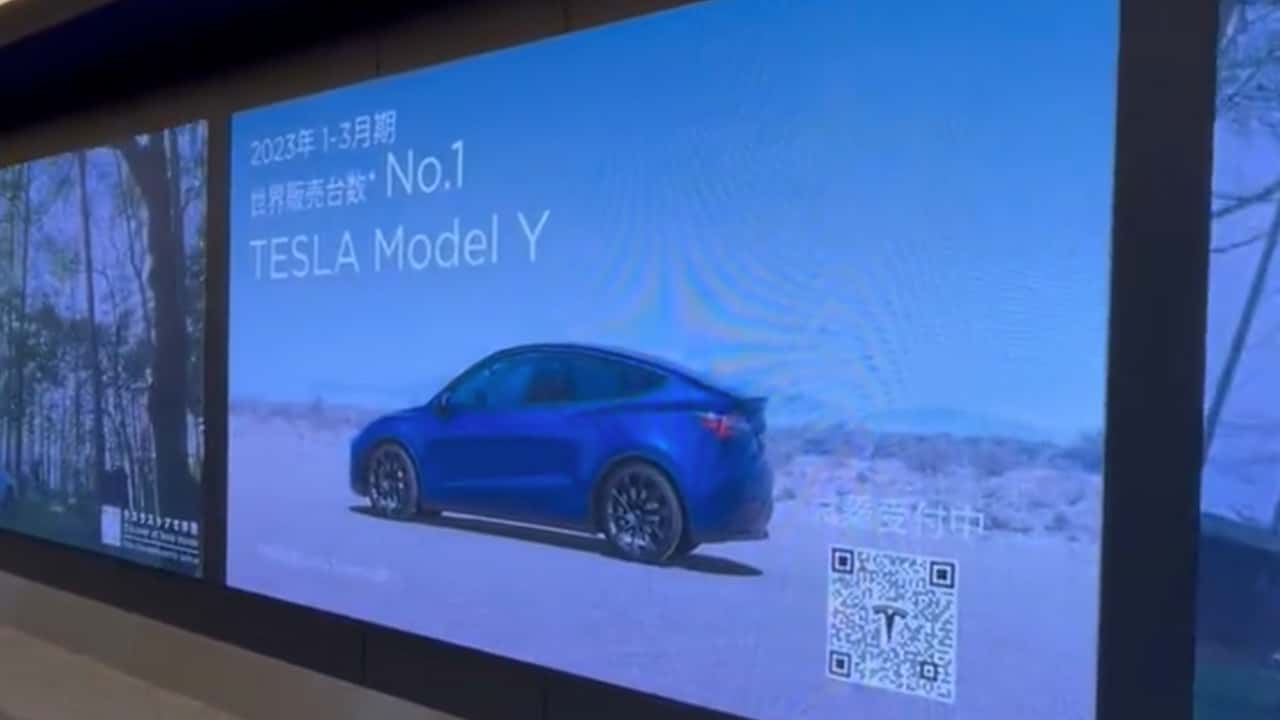Tesla Model Y advertisement spotted at Tokyo Haneda International Airport
An advertisement for the Tesla Model Y was recently seen at the Tokyo Haneda International Airport, marking a rare occurrence. The sighting was captured by a user on X (formerly Twitter), who shared a 19-second video on their personal account.
The video showcases images and various facts about the Model Y, which was the world’s best-selling car in the first quarter. These images were displayed on multiple big screens, highlighting features such as the Supercharger network, the Autopilot driving assistance system, and Camp Mode.
Notably, a QR code was also displayed on the screen, allowing passers-by to scan it with their smartphones and be redirected to Tesla’s local website.
This marks a significant shift for Tesla, as the company has long resisted paid advertising. However, earlier this year, CEO Elon Musk expressed willingness to explore advertising avenues. During a shareholders meeting in May, Musk stated that he decided to try “a little advertising” after someone in the audience questioned why Tesla doesn’t promote key selling points like over-the-air updates that enhance safety features.
Prior to this airport advertisement, Tesla had invested in Google ads that appear in search results and released a testimonial-style video filmed in Singapore, which was published on the Tesla Asia X account.
In terms of electric vehicle (EV) adoption in Japan, the numbers are still modest, with only 2.1 percent of new passenger cars sold being battery-powered cars in the fiscal year 2022. However, EV sales are steadily increasing. In the previous fiscal year, 77,238 EVs were purchased in Japan, a significant increase of 3.1 times compared to the previous year, according to Nikkei.
Despite this growth, Tesla is not one of the leading EV brands in Japan. Local manufacturers dominate the market with electric kei cars, with the Nissan Sakura being the top-selling EV in Japan in fiscal year 2022, followed by the Leaf and the Mitsubishi eK X. Therefore, advertising in Japan could be a strategic move for Tesla to raise brand awareness and potentially increase sales.
Japanese Airport Spotting Tesla Model Y Ads
In a world obsessed with technological advancements and eco-friendly transportation options, it comes as no surprise that Tesla, the American electric vehicle manufacturer, is finding its way into diverse markets around the globe. Recently, a major development has occurred in the land of the rising sun: Tesla Model Y advertisements have started to appear at various Japanese airports. This intriguing sight, seemingly out of place in a nation known for its strong domestic auto presence, raises questions about the changing landscape of the Japanese automotive industry and the increasing demand for electric vehicles.
Tesla’s decision to target Japanese airports with its Model Y ads is a strategic move that demonstrates a deep understanding of the potential of this market. Japan has traditionally been known for its domestically-produced automobiles, with giants like Toyota, Honda, and Nissan dominating the industry. However, the environmental challenges and the global shift towards sustainable transportation have prompted Japanese manufacturers to explore electric vehicle options more seriously.
The advertisements featuring the Model Y, Tesla’s latest addition to its lineup, are positioned at prominent locations within the airport facilities. This deliberate placement enables both domestic and international travelers to observe and consider Tesla’s offerings. The Model Y is particularly significant, as it falls into the compact SUV category, a popular choice among Japanese consumers. By showcasing the Model Y at airports, Tesla is targeting a diverse demographic, including Japanese residents, tourists, and business travelers, appealing to their curiosity and fostering familiarity with a brand that stands for innovative technology and environmental friendliness.
This move by Tesla comes as the Japanese government takes several measures to promote the adoption of electric vehicles, including providing incentives, expanding charging infrastructure, and implementing stricter emission regulations. Japan aims to have all new vehicles be electric or hybrid by 2050, and Tesla’s entrance into the market seems to align with this goal.
The timing of the advertisements is strategic as well. With Tokyo preparing to host the postponed 2020 Olympics, the airport becomes a major gateway for people from all over the world. Tesla’s presence at Japanese airports not only strengthens the brand’s visibility but also positions them as a viable alternative to traditional gasoline-powered vehicles, both for everyday transport and rental purposes. Consequently, Tesla’s initiative has the potential to generate significant interest among visitors to the country, who may then become advocates for the brand in their respective home countries.
The appearance of Tesla Model Y ads in Japanese airports carries broader implications, hinting at a gradual shift in consumer preferences. It signifies a growing interest in electric vehicles, particularly among millennials and forward-thinking individuals who prioritize sustainability and technological innovation. Disrupting the well-established market dominated by Japanese incumbents may present a challenge for Tesla, but it also reflects the allure and global impact of their brand.
In conclusion, the sight of Tesla Model Y ads at various Japanese airports is a significant development that highlights the changing dynamics of the Japanese automotive industry. Tesla’s strategic move not only targets a diverse audience but also aligns with the Japanese government’s push towards electric vehicle adoption. With the growing interest in sustainable transportation, Tesla’s decision to showcase their offerings in such a prominent setting demonstrates their commitment to expanding their global reach. As we witness the impact of this initiative, it is clear that the automotive landscape of Japan, and perhaps the world, is witnessing a transformative shift towards electric vehicles.

